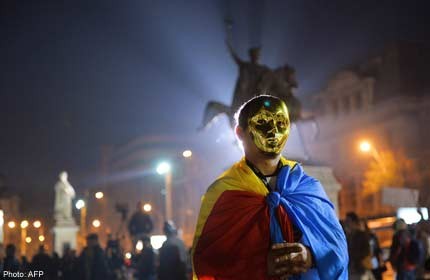Romania accused of shady moves to please Canadian gold mining firm

BUCHAREST - Romanian authorities have covered up crucial documents and sacked whistleblowing academics to please a Canadian company planning to open a huge gold mine in the heart of Transylvania, rights groups say.
The company, Gabriel Resources, hopes to extract 300 tonnes of gold from four mountains surrounding the picturesque village of Rosia Montana, in what is expected to become Europe's biggest open-cast mine.
With lawmakers expected to vote soon on a bill clearing the way for the mine, experts said the company and the government were striving to hide key data.
The Canadian company, which holds an 80-per cent stake in the Rosia Montana Gold Corporation (RMGC), plans to use large amounts of cyanide to separate gold from hundreds of millions of tonnes of rock.
The waste, containing heavy metals and cyanide, is to be stored in an artificial lake in the Corna Valley covering 360 hectares (900 acres) and contained by a 180-metre-high (590-foot) dam.
But geologists have warned that the site is underlain by fault-lines which will allow toxic substances to leak into the ground, and accused the company of using maps from which the faults had mysteriously vanished.
Displaying maps dating back to 1979 which clearly show faults in the Corna Valley, the sacked director of the Romanian Geological Institute (IGR), Stefan Marincea, told AFP: "The area is extremely permeable and the risk of groundwater contamination very high."
Marincea was dismissed by the government a few days after making the same argument before a parliamentary committee tasked with analysing the company's plans.
"I see no reason for my dismissal other than my insistence on telling the truth, which may anger some people today but will still be valid 20 years from now," he said.
Asked to comment on Marincea's allegations, the company said it had "never falsified any documents".
"The RMGC has used in good faith a map bought from the IGR which shows no major fault likely to affect the stability of the tailings lake and the dam," it said in a press release.
But geologist Costin Andrei told AFP that 19 open faults had been detected in the Corna area, with at least one of them undercrossing the dam.
Marincea also accused his predecessor at the IGR of altering the conclusions submitted by a team of experts after a 2011 visit to Rosia Montana.
The former director ignored their opinions and assured the environment ministry the site was safe for storing toxic substances, Marincea said.
"When I heard about this last summer, I nearly fainted... and I thought that one day I could be arrested" for not going public over the "falsified" report, he said.
'Return to the Inquisition'
Another key document, a study emphasising the value of Rosia Montana's cultural heritage and unique Roman-era mining galleries, was never released by the authorities.
AFP recently obtained a copy, whose authenticity was confirmed by the authors -- archaeology experts Andrew Wilson of Oxford University, David Mattingly of Leicester University and Michael Dawson of British consulting firm CgMs.
Stressing the "unique contribution of the area to world culture," the authors described the seven kilometres (four miles) of ancient galleries as "the most extensive and most important underground Roman gold mine known anywhere."
They also emphasised the value of Mount Carnic, which the RMGC plans to blow up if it gets the necessary permits.
"The Romanian government and the RMGC will be vulnerable to accusations of cultural vandalism if the mining project goes ahead," they said.
Kelemen Hunor, the culture minister who commissioned the study in 2009, said the document was meant to help him make a decision on the mine project but that he had "no duty" to release it.
He said that after reading it he decided against taking Mount Carnic off the list of protected historical monuments. But the national archeology commission ruled otherwise and gave its green light to the mine.
The current culture minister, Daniel Barbu, has said he does not see the area's heritage as an impediment to the RMGC's plans, prompting dozens of archeologists, historians and architects to call for his resignation.
Four of them, members of national committees that report to the culture ministry, were immediately sacked.
Several rights groups have accused Barbu of ignoring the British study to please the Canadian company.
"The stand taken by several Romanian officials is the same as the company's," Mircea Toma, president of Active Watch rights group, told AFP.
"The president, the prime minister, the culture and environment ministers have never made remarks that could displease the RMGC."
Active Watch battled for two years to get a copy of an agreement between the RMGC and the National Heritage Institute.
It received a copy only after a local court ruling and a bailiff's intervention.
Under the deal, the RMGC pledged to spend 70 million euros ($95 million) for restoration projects -- provided it obtained permits to start digging.
The Soros Foundation Romania, part of US billionaire George Soros's philanthropy network, also condemned the sacking of experts "simply because their opinions run counter to the authorities' interests".
It said it was unacceptable to "ask public servants to choose between their professional integrity and the security of their job."
"Telling academics what they can say and what they cannot looks to me like a return to the Inquisition," said Marincea.
"Will the next step be to burn us at the stake?"